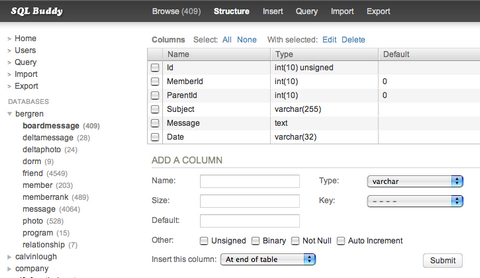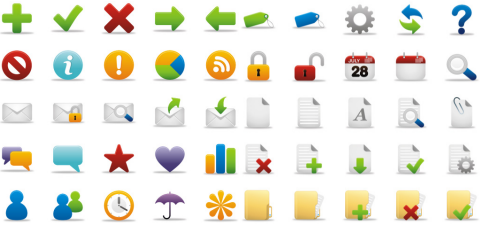Some applications look great in a screenshot, but deliver disappointing results when they are actually used. The driving force behind the development of SQL Buddy was not to produce a great-looking screenshot but rather to create a product that would enable developers to enjoy their work and get more done in less time. SQL Buddy is a web based MySQL Administration Tool similar to phpMyAdmin.
It is really easy to install SQL Buddy, just unzip the files to your server and its ready to use. You can easily find the data you are looking for with columns that can be ordered and resized. And instead of reloading the entire page structure with each request, ajax is used to fetch just the content that has changed. At the same time, it still plays nice with bookmarks, the back button, etc.

Requirements: –
Demo: http://sqlbuddy.com/
License: MIT License
DryIcons has released a new beautiful free icon set called “Coquette“. “Coquette” will make sure to bring all attention and admiration to your software applications, websites, blogs.This playful free icon set contains curvy and colorful free icons made with one goal, to get all the affection to your projects.
These free icons flirt with style. “Coquette” free icon set contains 50 high quality, free icons in these sizes: 16x16px, 32x32px, 48x48px, 64x64px and 128x128px and 32-bit transparency PNG file format.

Requirements: –
Demo: http://dryicons.com/free-icons/preview/coquette-icons-set/
License: Terms of Use
iPhone Web Apps combine the power of the Internet with the simplicity of Multi-Touch technology, all on a 3.5-inch screen. When you find a web app you like, you can put it on your Home screen for easy, one-tap access.
There are over 600 Web Apps available, I found many of them are useless to be honest. So,what are the best ones? iPhone Toolbox has carefully selected top 25 iPhone Web Apps for us. Feel free to share your favorite ones on the post as well.

Source: Top 25 Free iPhone Web Apps for Your Daily Life
The YUI team is pleased to announce the public availability of YUI 3.0 Preview Release 1, an early look at what they’re working on for the next generation of the YUI Library. Documentation for YUI 3.0 is on the YUI website; the download is available on the YUI project area on SourceForge; Keep in mind that this is an early preview, not a production-quality (or even a beta) release. This release is not suitable for production use, but it will give you an idea of what they’re working on, and it should provide a good framework for conversation about the future of the library. They’ve set five design goals for the next generation of the library. What you’ve told us is that YUI 3.0 should be:
- lighter (less K-weight on the wire and on the page for most uses)
- faster (fewer http requests, less code to write and compile, more efficient code)
- more consistent (common naming, event signatures, and widget APIs throughout the library)
- more powerful (do more with less implementation code)
- more securable (safer and easier to expose to multiple developers working in the same environment)

Requirements: –
Demo: http://developer.yahoo.com/yui/3/
License: BSD License

The Email Standards Project is about working with email client developers and the design community to improve web standards support and accessibility in email. The project was formed out of frustration with the inconsistent rendering of HTML emails in major email clients.
Their mission is to drive the use and support of web standards in email, working with email client developers to ensure that emails render consistently. This is a community effort to improve the email experience for designers and readers, and they’d love your help.
They would like to help web designers understand why web standards matter for email, so that they are willing to get involved in making it happen. And also, they are providing as much assistance and feedback to the email client developers as they can. You can see the beginnings of this with their email acid test results.
Source: http://www.email-standards.org/

Suhosin is an advanced protection system for PHP installations. It was designed to protect servers and users from known and unknown flaws in PHP applications and the PHP core. Suhosin comes in two independent parts, that can be used separately or in combination. The first part is a small patch against the PHP core, that implements a few low-level protections against bufferoverflows or format string vulnerabilities and the second part is a powerful PHP extension that implements all the other protections.
If you are using PHP only for your own server and only for your own scripts and applications, then you can judge for yourself, if you trust your code enough. In that case you most probably don’t need the Suhosin extension. Because most of it’s features are meant to protect servers against vulnerable programming techniques. However PHP is a very complex programming language with a lot of pitfalls that are often overseen during the development of applications. Even PHP core programmers are writing insecure code from time to time, because they did not know about a PHP pitfall. Therefore it is always a good idea to have Suhosin as your safety net.
P.S. Suhosin (ìˆ˜í˜¸ì‹ ) is a south-korean word that means something very similiar to the english guardian-angel.
Requirements: –
Demo: http://www.hardened-php.net/suhosin/
License: PHP License 3.01

IMG·2·JSON is a simple Google App Engine python application which extracts metadata from images and returns the results as a JSON string. To use IMG·2·JSON all you need to do is perform a request for the fetcher-script URL hosted on Google App Engine.
And then it will return the mimeType, width, height, byteSize and EXIF metadata extracted from the image (such as Camera Manufacturer, Model, Orientation, Date, GPS position, etc). I found it useful for developing web application that needs to identify, sort or find images. How about developing a search engine for images?
Requirements: –
Demo: http://img2json.appspot.com/
License: License Free
Canvas 3D Graph is a special type of bar graph that plot numbers in 3D. <canvas> tag is not supported in IE, so the author was forced to use excanvas.js in order to draw graph in IE. As the result of that, you may experience some freezes when you try to plot large amount of data in IE. Firefox and safari works just fine (aprox 10x faster than emulated canvas in IE). This is initial release, he planned to add many more features, so stay stay tuned for the updates.

Requirements: –
Demo: http://dragan.yourtree.org/code/canvas-3d-graph/
License: BSD License
The common stereotype for programmers is this: nerdy, pocket-protector wielding, and very, very boring. One doesn’t typically link a programmer as a creative individual. However, this couldn’t be farther from the truth. Working with code is one of the most creative jobs one can have. Programmers have to balance two very different worlds: a world of structure and a world of imagination. They create abstract concepts using very structured programming languages (like PHP or Java). It’s not an easy task. Programming is actually a great exercise in creativity. Here are a couple reasons why:
- Programming gives ultimate control. Creating something from nothing is possibly the best example of creativity. The ultimate control over software or web site that a programmer has is perfect for taking the application to any direction that they wish.
- Many ways to do one thing. Programmers have to essentially build a framework for the web site. They’re laying the foundation for something that, up until that point, is just an idea. The programmer uses a wide palate of tools and methods to find
Programmers are a great example of thinking outside the box because programmers can actually create the box. Here are 14 ways to Learn From Creative Programmers.
1. Learn a new language
2. Start from the ground up
3. Question everything
4. Do it for fun
5. Never stop testing ideas
6. Find a passion
7. Master your tools
8. Start making abstract associations
9. Think of structure as a tool, not a limitation
10. Don’t rule anything out until you try it.
11. Always look for a simpler and more elegant solution.
12. Don’t be afraid to build off the code of others.
13. Don’t be afraid to collaborate.
14. From the very basic, create the beautiful.
Source: 14 Ways to Learn From Creative Programmers

ShiftSpace is an open source layer above any website. It seeks to expand the creative possibilities currently provided through the web. ShiftSpace provides tools for artists, designers, architects, activists, developers, students, researchers, and hobbyists to create online contexts built in and on top of websites.
By pressing the [shift] + [space] keys, a ShiftSpace user can invoke a new meta layer above any web page to browse and create additional interpretations, contextualizations and interventions – which we call Shifts. Users can choose between several authoring tools we’re working to develop – which we call Spaces. Some are utilitarian (like Notes and Highlights) and some are more interventionist (like ImageSwap and SourceShift). Users will be invited to map these shifts into Trails. These trails can be used for collaborative research, curating netart exhibitions or as platforms for context-based public debates.
Notes is a Space that allows a ShiftSpace user to leave post-it annotations on websites. Highlights is one we’re still developing, which would allow a user to highlight text on the page. Some Spaces lead more naturally to an interventionist usage. Two such Spaces that we have implemented are ImageSwap, which allows a user to grab any image on the web and swap it in place of other image, and SourceShift, which allows users to freely edit a page’s HTML code.
When a user visits a modified (’Shifted’) webpage, the small ShiftSpace icon (§) pops up in the bottom left side of the screen. Pressing the [shift] + [space] keys reveals the ShiftSpace console. From the console, the user can browse through existing Shifts, choosing to enable those that might be of interest. Holding down the [shift] key shows a small contextual menu, allowing the user to create Shifts of her own. The user can then choose whether to share her Shifts or to keep them private.

Source: http://www.shiftspace.org/












